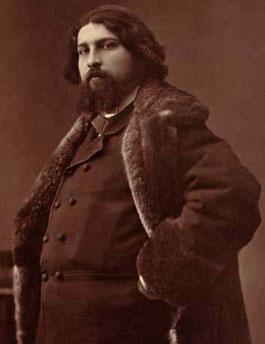| Daniel Vierge  Born: 1851 Born: 1851
Birthplace: Madrid, Spain
Died: May-1904
Location of death: Boulogne-sur-Seine, France
Cause of death: unspecified
Gender: Male
Race or Ethnicity: White
Sexual orientation: Straight
Occupation: Artist Nationality: Spain
Executive summary: Spanish painter and illustrator Spanish painter and draughtsman, was born in Madrid in 1851. He went to Paris in 1867 to seek his fortune, fired by the vivid energy of his national temperament. He became attached to the Monde Illustré in 1870, just before the Franco-Prussian War broke out, and, like other artists in the paper, came under the powerful influence of Edmond Morin, the first newspaper draughtsman in France who sought to impart to drawings for journals the character of a work of art. Vierge's earlier drawings, therefore, partake greatly of Morin's style; such are, The Shooting in the Rue de la Paix, The Place d'Armes at Versailles, The Loan The Great School-Fete of Lyons, Anniversary of the Fight of Aydes and Souvenir of Coulmiers.
Vierge lost no time in proving the extraordinary vigor and picturesqueness of his art. Apart from the contribution of his own original work, he was required by his paper to redraw upon the wood, for the engraver, the sketches sent in by artist-correspondents, such as Luc Ollivier Merson in Rome and Samuel Urrabieta (Vierge's brother) in Spain. From 1871 to 1878 his individuality became more and more pronounced, and he produced, among his best-known drawings, Christmas in Spain, The Republican Meeting in Trafalgar Square, Attack on a Train in Andalusia, Feast of St Rosalia in Palermo, In the Jardin d'Acclimatation, The Burning of the Library of the Escurial, 1872, Grasshoppers in Algiers, Brigandage in Sicily, Night Fete in Constantinople, Episode of the Civil War in Spain, Marriage of the King of Spain and The Bull Fight. About this time he illustrated with remarkable dash and skill Victor Hugo's Année Terrible (Michel Levy, 1874, and Hugues, 1879), 1813 (Hugues, 1877) and Les Misérables (1882). His masterpiece of illustration is Michelet's History of France (1876), consisting of 26 volumes containing 1000 drawings.
In 1879 he was drawing for La Vie Moderne, and then proceeded to illustrate Pablo de Segovia. While engaged upon this work he was attacked by paralysis in the right arm, but with characteristic energy and courage he set himself to acquire the necessary skill in drawing with the left, and calmly proceeded with the illustrations to the book. In 1891 he illustrated L'Espagnole, by Bergerat, and in 1895 Le Cabaret des Trois Vertus. In 1898 he held, at the Pelletan Gallery in Paris, an exhibition of his drawings for Chateaubriand's Le Dernier Abencérage ("The Last of the Abencerrages"), and in the following year a comprehensive exhibition of his work (including the illustrations to Don Quixote) at the Art Nouveau Gallery, also in Paris. In 1898 Vierge contributed to L'Image, a magazine devoted to the encouragement of engraving upon wood; and two years later, at the International Exhibition at Paris, he was awarded a grand prix. In 1902 he exhibited at the New Salon a scene from the Franco-Prussian War. He died at Boulogne-sur-Seine in May 1904.
Do you know something we don't?
Submit a correction or make a comment about this profile
Copyright ©2019 Soylent Communications
|